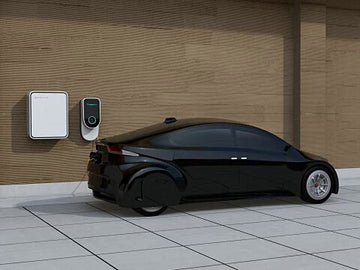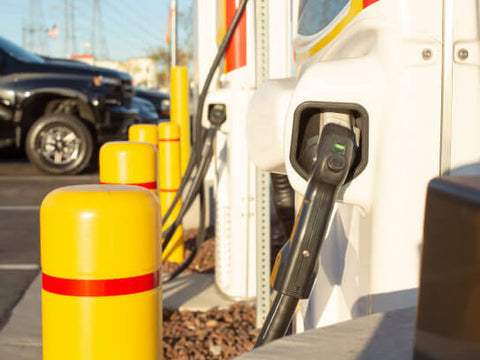
Ever pulled up to an EV charging station only to find the plug doesn't fit your car? Believe it or not, there are two main connector standards for electric vehicle charging: Type 1 and Type 2. This can be frustrating, especially if you're on a road trip! This exploration will shed light on these two standards, explaining their key differences. But more importantly, we'll reveal which regions primarily use each type. By the end, you'll be a whiz at navigating charging stations and avoiding adapter headaches on your next electric adventure!
Type 1 Chargers
Type 1 chargers, also known as SAE J1772 connectors, are prevalent in certain regions and offer unique characteristics that cater to specific electric vehicle (EV) markets.
Defining Characteristics of Type 1 Chargers
Type 1 chargers feature a single-phase connector with five pins, designed to facilitate communication between the EV and the charging station. They are known for their safety features, including locking mechanisms that secure the connector in place during charging and prevent accidental disconnection. Type 1 chargers typically support Level 1 charging, delivering power directly from a standard household outlet, or Level 2 charging, using dedicated charging stations with higher power output.
Primary Connector Standard in North America
Type 1 chargers are the primary connector standard in North America, particularly in the United States and Canada. This standardization simplifies EV charging infrastructure and ensures compatibility across different EV models. In these regions, Type 1 chargers are widely deployed in public charging stations, workplaces, and residential settings, supporting the growing adoption of electric vehicles.
Major Regions Using Type 1 Chargers
Apart from North America, Type 1 chargers are also prevalent in Japan. The adoption of Type 1 chargers in Japan can be attributed to historical development and industry standards prevalent in the country's automotive sector. Japanese automakers, such as Nissan and Mitsubishi, have historically utilized Type 1 connectors in their EV models, contributing to the widespread use of Type 1 chargers in the Japanese market.
Reasons for Adoption of Type 1 Standard
The adoption of Type 1 chargers as the standard connector in North America and Japan is influenced by several factors. Historically, Type 1 connectors emerged as a result of collaboration between automakers and charging infrastructure providers to establish a common interface for EV charging. Additionally, industry standards such as SAE J1772 in North America and CHAdeMO in Japan have contributed to the widespread adoption of Type 1 chargers in these regions, ensuring interoperability and safety in EV charging systems.
Ultimately, Type 1 chargers offer unique characteristics tailored to specific regions, serving as the primary connector standard in North America and Japan. Their adoption is driven by historical development, industry standards, and collaboration among automakers and stakeholders to promote interoperability and safety in EV charging infrastructure.
Type 2 Chargers
Type 2 chargers, known for their versatility and capability to handle both AC and DC charging, play a significant role in advancing electric vehicle (EV) infrastructure, particularly in Europe and emerging markets like China.
Key Features of Type 2 Chargers
Type 2 chargers boast several key features that make them highly versatile for EV charging. They support both AC (alternating current) and DC (direct current) charging, allowing them to accommodate a wide range of EV models with different charging requirements. This versatility makes Type 2 chargers suitable for both home charging and public charging stations, offering convenience and flexibility to EV owners.
Dominant Connector Standard in Europe
Type 2 chargers are the dominant connector standard in Europe, particularly in major countries like Germany, France, and the United Kingdom. The widespread adoption of Type 2 connectors in Europe has facilitated the development of a robust EV charging infrastructure, including public charging networks, workplace charging, and residential charging solutions. This standardization ensures interoperability and compatibility across different EV models, driving the uptake of electric vehicles in the region.
Gaining Traction in China
In recent years, Type 2 chargers have been gaining traction in China, a significant market for electric vehicles. As China continues to promote the adoption of electric vehicles and invest in EV infrastructure, Type 2 connectors have emerged as a preferred choice for charging stations. The adoption of Type 2 chargers in China reflects the country's commitment to fostering a sustainable transportation ecosystem and reducing reliance on traditional fossil fuels.
Factors Influencing Adoption of Type 2
Several factors have influenced the adoption of Type 2 chargers in Europe and China. In Europe, government regulations and industry collaboration have played a crucial role in establishing Type 2 as the dominant connector standard. Regulations mandating standardization of charging infrastructure and interoperability have incentivized the widespread deployment of Type 2 chargers across the continent. Similarly, in China, government initiatives to promote electric vehicles and invest in EV charging infrastructure have propelled the adoption of Type 2 connectors.
Comparing and Contrasting
Type 1 and Type 2 chargers offer distinct functionalities and cater to different regional preferences, but efforts towards global standardization may shape their future development.
Functionality Differences
Type 1 chargers are primarily AC chargers, meaning they deliver power in the form of alternating current to the electric vehicle's onboard charger for conversion into direct current. In contrast, Type 2 chargers are more versatile, capable of delivering both AC and DC power directly to the vehicle's battery. This flexibility allows Type 2 chargers to support a broader range of EV models with varying charging capabilities, making them well-suited for Level 2 EV charger applications.
Regional Availability
Regional availability plays a significant role in determining the prevalence of charger types. Type 1 chargers are the standard connector in North America, including the United States and Canada, while Type 2 chargers dominate the European market, with widespread adoption in major countries like Germany, France, and the United Kingdom. Emerging markets like China may see a mix of both charger types as they develop their EV infrastructure, with a growing emphasis on Level 2 EV chargers to support faster charging speeds.
Push for Greater Standardization
There is a growing push for greater standardization in EV charging infrastructure globally to facilitate interoperability and compatibility among different EV models and charging stations. Standardization efforts aim to streamline the EV charging experience for consumers, reduce confusion, and encourage the widespread adoption of electric vehicles. Organizations like the International Electrotechnical Commission (IEC) and the Society of Automotive Engineers (SAE) are working towards establishing common standards for EV chargers and connectors, including Level 2 EV chargers.
Future Outlook
The future of Type 1 and Type 2 chargers depends on various factors, including technological advancements, regulatory frameworks, and market demand. While Type 1 chargers may continue to be prevalent in North America, Type 2 chargers are expected to gain further traction globally, driven by their versatility and compatibility with AC and DC charging. As EV adoption rates continue to rise and charging infrastructure evolves, we may see increased interoperability and convergence towards standardized charging solutions worldwide, including Level 2 EV chargers.
Challenges and Solutions of Regional Charger Standards for EV Owners
Type 1 chargers are predominantly used in North America, particularly in the United States and Canada, while Type 2 chargers are the standard connector in Europe, including major countries like Germany, France, and the United Kingdom.
Cross-Regional Travel Challenges
EV owners traveling across regions with different charger standards may encounter challenges related to charger compatibility. For example, an EV equipped with a Type 1 connector may face difficulties accessing charging infrastructure in Europe, where Type 2 chargers are prevalent. This disparity could lead to range anxiety and inconvenience, potentially necessitating the use of adapters to enable charging at incompatible stations.
Importance of Charger Compatibility
Understanding charger compatibility is crucial for ensuring a smooth EV charging experience, especially for travelers and individuals living in regions with diverse charger standards. By knowing which charger type their EV supports and the prevalent standards in their destination, EV owners can plan their routes effectively, avoid compatibility issues, and ensure access to charging infrastructure throughout their journey. Additionally, awareness of charger compatibility helps EV owners make informed decisions when purchasing adapters or selecting charging stations, minimizing the risk of encountering compatibility issues and maximizing the efficiency of their charging sessions.
FAQs / People Also Ask
Q: Which regions primarily use Type 1 chargers?
A: Type 1 chargers are predominantly used in North America, particularly in the United States and Canada.
Q: Where are Type 2 chargers primarily used?
A: Type 2 chargers are the standard connector in Europe, including major countries like Germany, France, and the United Kingdom.
Q: Are there any other regions where Type 1 or Type 2 chargers are prevalent?
A: While Type 1 and Type 2 chargers are the primary standards in North America and Europe, respectively, there may be some variations in other regions. However, these two charger types are the most widely adopted standards globally.
Q: Why is it important to know which charger type is prevalent in a region?
A: Understanding regional charger standards is crucial for EV owners, as it helps them plan their routes effectively and ensure access to compatible charging infrastructure. Knowing which charger type predominates in a region allows EV owners to avoid compatibility issues and optimize their charging experience.
Q: Can EV owners use adapters to charge their vehicles in regions with different charger standards?
A: Yes, adapters are available to enable charging compatibility between different charger types. However, it's essential for EV owners to verify the compatibility of adapters with their vehicles and charging stations before use to ensure safe and efficient charging.





